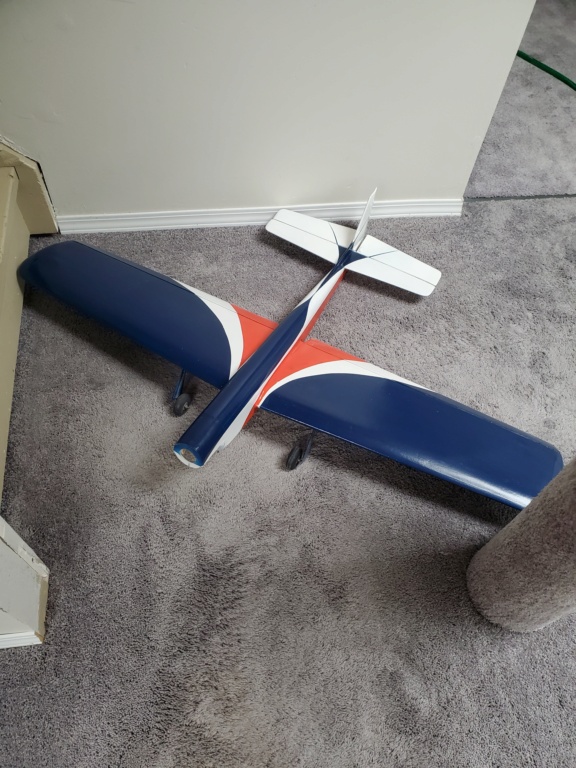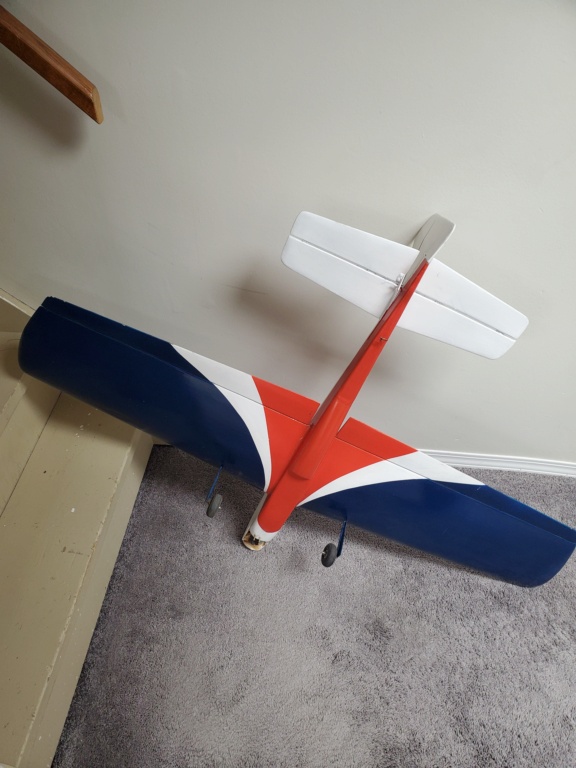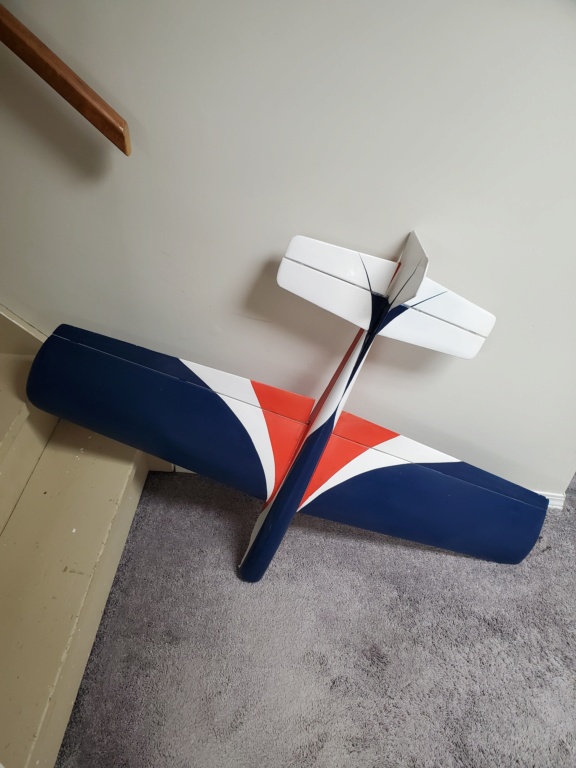Log in
Search
Latest topics
» Free Flight Radio Assist by MauricioB Today at 9:33 pm
» Roger Harris revisited
by MauricioB Today at 9:30 pm
» A Little 400 Mile Hop for Some Memory Lane Stuff, and to Hit a Swap Meet.
by MauricioB Today at 9:20 pm
» Duende V model from RC Model magazine 1983.
by MauricioB Today at 9:03 pm
» Happy 77th birthday Andrew!
by Kim Yesterday at 9:18 am
» Promote the forum with flyers!
by Admin Yesterday at 1:35 am
» Engine choice
by GallopingGhostler Mon Nov 25, 2024 4:03 pm
» My N-1R build log
by roddie Mon Nov 25, 2024 9:19 am
» Night flying at Walters RC park
by 1975 control line guy Sun Nov 24, 2024 7:29 pm
» Cox films/videos...
by GallopingGhostler Sun Nov 24, 2024 7:07 pm
» Cox 020 PeeWee rebuild questions
by LooseSpinner99 Sun Nov 24, 2024 6:13 pm
» Did you spot the Cox engine in this NASA research video?
by balogh Sun Nov 24, 2024 5:08 pm
Cox Engine of The Month
Sig Mustang Stunter
Page 1 of 1
 Sig Mustang Stunter
Sig Mustang Stunter
So last Friday I was picking up a free flight kit for my buddy and one for myself. While there, I was offered a 'plane' for a very reasonable price. So I bit on the offer as it was someone I kinda knew and dealt with before locally. Turnes out it is a Sig Mustang Stunter with Fox 35. Only missing was a thrust washer, prop washer, and nut. Engine was siezed. Brought it home, removed the engine and heated it up a bit with a few drops of fuel and it flips over and pops very well ( I took the parts from my Shoestring). Only thing missing is teh canopy, but was never installed, nor do I think the plane was ever flown, or engine run as it is spotless, but I think just factory gummed up, Fox 35 40th Anniversary Edition. It's late here, but will try to get a couple of pics up tomorrow.

NEW222- Top Poster

- Posts : 3896
Join date : 2011-08-13
Age : 46
Location : oakbank, mb
 Re: Sig Mustang Stunter
Re: Sig Mustang Stunter
I have one Mustang Stunter kit left. I've built two of them over the years. First one, too heavy for the Fox .35. If the winds kicked up even to 10 mph it was getting blown out of the sky. I also didn't know what I know now about the Fox .35. I built my first one at 15-16 yrs old. Also, in regards to building, I could've saved ounces on them. This is how you learn though. They don't fly too bad, my second one was powered by a OS FP-S.40. I purchased that engine in 1988 for $56.00. The receipt is still in the box. Much more oomph with the FP compared to the Fox. 1988 was the year the 40th Anniversary was introduced. What many didn't realize initially was the significance of the 40th anniversary.
The version prior to the 40th which is what I refer to as the red, white , black box 80's versions were hit or miss. Like most Fox's you purchased 10 ran them all, cherry picked the good ones and sold the rest to your competitors or friends. You either received a fair to moderate one or a real POS! Mostly were POS versions. In typical Duke Fox fashion, the machinery is outdated, the castings were wore out, quantity over quality and the price remained the same. Therefore, your engine had poor fits, the castings had more flash and slag inside the engine then outside. I had one engine where the head was installed 180 and the baffle of the piston was striking the top of the head. These engines looked so bad on the outside he just glass beaded them to make them appealing.
Enough people complained about this and the 40th was revamped with a cleaner casting, tighter fits in fact some were too tight and instead of black oxide finish on exterior parts, they were plated. The real problem though with the 80's version and the 40th is that Duke never revised the muffler mounts and it still used the POS method of the ears on the side of the case. These instantly broke off in a crash. If they didn't break in a crash, they broke from vibration.
Most were giving up on the 40th because they were not breaking in. I pretty much take them apart and polish and lap the piston sleeve and I generally can have one flying out of the box in less than a hour. So while most are trying to run a gallon of fuel through it, I was flying. The connecting rod looks like they were made by a caveman using period tools. It's imperative to insure that the engine isn't so tight that you damage the rod. Constant running on a tight engine beats the rod into submission so it's essentially wore out by the time it's broken in. A Fox that's not broken in will lean up, sag and then seize up. If this is constantly done, it's not very good for it.
The Sig Mustang also uses a inverted engine. If one isn't familiar with this, the end result is just frustration. Don't flood a inverted engine, not only will it not start, it will take out the plug instantly. In addition, if the tank height is incorrect, the case fills with fuel and the engine locks up. Start it upside down if needed. I personally wouldn't start it in the plane if you feel the engine is new or near new. It's not very good for the plane when it's shaking real bad. That's exactly what a new Fox is going to do.
The version prior to the 40th which is what I refer to as the red, white , black box 80's versions were hit or miss. Like most Fox's you purchased 10 ran them all, cherry picked the good ones and sold the rest to your competitors or friends. You either received a fair to moderate one or a real POS! Mostly were POS versions. In typical Duke Fox fashion, the machinery is outdated, the castings were wore out, quantity over quality and the price remained the same. Therefore, your engine had poor fits, the castings had more flash and slag inside the engine then outside. I had one engine where the head was installed 180 and the baffle of the piston was striking the top of the head. These engines looked so bad on the outside he just glass beaded them to make them appealing.
Enough people complained about this and the 40th was revamped with a cleaner casting, tighter fits in fact some were too tight and instead of black oxide finish on exterior parts, they were plated. The real problem though with the 80's version and the 40th is that Duke never revised the muffler mounts and it still used the POS method of the ears on the side of the case. These instantly broke off in a crash. If they didn't break in a crash, they broke from vibration.
Most were giving up on the 40th because they were not breaking in. I pretty much take them apart and polish and lap the piston sleeve and I generally can have one flying out of the box in less than a hour. So while most are trying to run a gallon of fuel through it, I was flying. The connecting rod looks like they were made by a caveman using period tools. It's imperative to insure that the engine isn't so tight that you damage the rod. Constant running on a tight engine beats the rod into submission so it's essentially wore out by the time it's broken in. A Fox that's not broken in will lean up, sag and then seize up. If this is constantly done, it's not very good for it.
The Sig Mustang also uses a inverted engine. If one isn't familiar with this, the end result is just frustration. Don't flood a inverted engine, not only will it not start, it will take out the plug instantly. In addition, if the tank height is incorrect, the case fills with fuel and the engine locks up. Start it upside down if needed. I personally wouldn't start it in the plane if you feel the engine is new or near new. It's not very good for the plane when it's shaking real bad. That's exactly what a new Fox is going to do.

Ken Cook- Top Poster

- Posts : 5644
Join date : 2012-03-27
Location : pennsylvania
 Re: Sig Mustang Stunter
Re: Sig Mustang Stunter
Thanks Ken for the info on the Fox 40th. I have had mine for more than a few years from a swap meet. It appears that it might have been run very little, at least that's what the mounting lugs tell me, and no head blackening. The head and back plate screws have been replaced with cap screws. Speaking of the back plate, it is not the normal, same color as the engine back plate. This 40th has what appears to be a blueish steel color back plate, that I don't see on other Fox's. The needle is not the normal spade type, but just a taper down to a blunt end. This engine doesn't look like a normal Fox Stunt as my other's do, down to my .19 and the rare 25 Stunt engine. At present I have this engine mounted on a newly built Sterling "T" Square. I have as yet to run this engine. Eddy

Eddy- Silver Member

- Posts : 94
Join date : 2018-04-29
Age : 80
Location : Portage, Michigan
 Re: Sig Mustang Stunter
Re: Sig Mustang Stunter
Eddy, the 40th anniversary was the last of the tapered needle with the flat on one side. The newer replacement is tapered but as you mentioned, the end is blunt as it doesn't come to a point. The spraybar for both of these needles is the two hole version. The spade style that I've come across uses the single hole spraybar and I typically see these in the .36X. If you look down the throat of the venturi, you shouldn't be able to see the holes. Many times, one of these holes is higher and it's been suggested that they're made like this. I truly feel that it's accidental due to the drill going through the one side and then flexing when it hits the inside radius and then breaks out the other side. I remove any burrs around the holes. Insuring that the spraybar is correctly positioned is important as it can change the break of the engine when it transitions from level to upright.
As far as the backplate is concerned, I remove the backplate and sand all the imperfections of the back of the case off on top of a piece of glass with 400 grit paper. Oil helps keep the paper from loading and assists in getting the job done faster. Once the back is flat, I tack glue a piece of 400 to the back of the case and I lap the backplate to it by rotating it over the paper. The backplate of the Fox is cast and it's poorly done as it has a extreme radius on the inside. The gasket fits poorly due to it being circular and it doesn't extend under the ears of the backplate. DO NOT OVERTIGHTEN as it bends the ear due to the cork gasket being quite thick. The gasket will also squash out. If a Fox backplate isn't sealed, the engine will shut off at weird times as if a switch was thrown.
Fox did make a stuffer backplate. This backplate was machined and not cast. It protruded more into the case, the ears are also substantially thicker and it was anodized with a hard coating. You mentioned yours is bluish, my versions are noticeably a different color over the rest of the crankcase but it's more like a grayish or olive color. The importance here is that the stock backplate doesn't protrude enough into the case which the rod can work back and forth on the pin. This also causes quick wear to not only the rod but the shaft starts egging out the case as well. On a stock backplate this is recognizable by the uneven wear marks on the backplate.
In the 90's Fox offered the hemi head and stuffer backplate separately. The hemi head is a two piece head. I can provide pictures if you would like.
As far as the backplate is concerned, I remove the backplate and sand all the imperfections of the back of the case off on top of a piece of glass with 400 grit paper. Oil helps keep the paper from loading and assists in getting the job done faster. Once the back is flat, I tack glue a piece of 400 to the back of the case and I lap the backplate to it by rotating it over the paper. The backplate of the Fox is cast and it's poorly done as it has a extreme radius on the inside. The gasket fits poorly due to it being circular and it doesn't extend under the ears of the backplate. DO NOT OVERTIGHTEN as it bends the ear due to the cork gasket being quite thick. The gasket will also squash out. If a Fox backplate isn't sealed, the engine will shut off at weird times as if a switch was thrown.
Fox did make a stuffer backplate. This backplate was machined and not cast. It protruded more into the case, the ears are also substantially thicker and it was anodized with a hard coating. You mentioned yours is bluish, my versions are noticeably a different color over the rest of the crankcase but it's more like a grayish or olive color. The importance here is that the stock backplate doesn't protrude enough into the case which the rod can work back and forth on the pin. This also causes quick wear to not only the rod but the shaft starts egging out the case as well. On a stock backplate this is recognizable by the uneven wear marks on the backplate.
In the 90's Fox offered the hemi head and stuffer backplate separately. The hemi head is a two piece head. I can provide pictures if you would like.

Ken Cook- Top Poster

- Posts : 5644
Join date : 2012-03-27
Location : pennsylvania
 Re: Sig Mustang Stunter
Re: Sig Mustang Stunter
Ken, thank's again for your info. I looked again at my Fox 40th and the back plate is not cast as the engine is, but has been machined as the swirl marks show all over. It is gun metal blue in color and non magnetic. Wish I could post a picture, but this old computer with windows 7 just won't let me. Anyway, many thanks again, I will do more looking on the internet on this Fox. Eddy

Eddy- Silver Member

- Posts : 94
Join date : 2018-04-29
Age : 80
Location : Portage, Michigan

NEW222- Top Poster

- Posts : 3896
Join date : 2011-08-13
Age : 46
Location : oakbank, mb
 Similar topics
Similar topics» New Project
» "Barbie's stunter"
» P-40 Kittyhawk Stunter
» 1/2A Charger C/L stunter
» My Shoestring Stunter is RTF
» "Barbie's stunter"
» P-40 Kittyhawk Stunter
» 1/2A Charger C/L stunter
» My Shoestring Stunter is RTF
Page 1 of 1
Permissions in this forum:
You cannot reply to topics in this forum

 Rules
Rules










